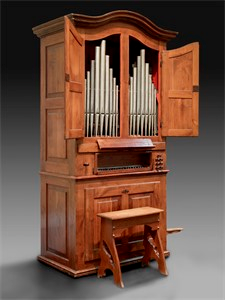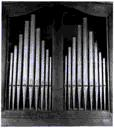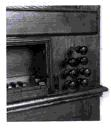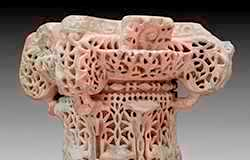
This image is restricted, permission must be requested for reproduction. Downloading for commercial use is prohibited. If you wish to obtain rights to reproduce this image please see our Rights and Reproductions page.
Pascoali Caetano Oldovini (aka Pasquale Gaetano Oldovini)
(active 1758 - 1785)
Organ
Órgan
c. 1762
Chestnut wood case, boxwood & ebony keys, tin & organ metal
102 1/4 x 49 1/2 x 28 1/4 in. (259.7 x 125.7 x 71.8 cm)
Century: 18th Century
Credit Line: Meadows Museum, SMU, Dallas. Gift of The Meadows Foundation, MM.83.05
Accession Number: MM.83.05
More Information
Visual Description
This organ stands approximately eight and half feet tall and four and half feet wide and is housed in a wooden case and with an arched top. There are two doors in the front of the case that open outward to reveal the organ's pipes. There are nine pipes behind each door opening, arranged with the tallest and largest pipe in the center and descending in scale on either side. Below the pipes, set into a rectangular alcove, is a small keyboard made of boxwood and ebony keys approximately two feet in length. To the right of the keyboard are five darker wooden draw-knobs which operate the seven registers of the organ. To the left of the keyboard is another wooden knob which is the nightingale or bird stop, which makes a whistle like a bird. Below that are two rectangular inset panels. There is a small two foot high wood bench that sits to the side when the organ is not in use.
Gallery Label
This single-manual organ, built for the Cathedral of Evora, Portugal, is the only instrument by Oldovini to be found outside the Iberian peninsula. Restored to playing condition by the Flentrop Orgelbouw of Zandaam, Holland, in 1967, all parts of the instrument are original except for three small pipes and a restored “Nightingale” stop.
The single keyboard has a compass of 45 notes (C/E bass short octave to c3). There are seven registers, each operated by one of the draw-knobs to the right of the keyboard: Flautado Abº 12 (Open Principal 8’ – from tenor A); Flautado Tapº 12 (Stopped Flute 8’ – the pipes from C to tenor A always play; CDEFGA have a second rank sounding one octave higher); Outava real (Principal 4’ – from the lowest B-flat); Outava de 3 (Principal 2’); Cheo primeiro; Cheo secundo (two mixtures of two ranks each); Cornetilha (2 2/3’ and 1 3/5’ ranks, sounding from middle C-sharp). The rossignol (bird stop) is operated by the stop-knob to the left of the keyboard. Although there is a small modern electric blower to provide wind for the instrument, the original foot pumping mechanism remains operable.
The single keyboard has a compass of 45 notes (C/E bass short octave to c3). There are seven registers, each operated by one of the draw-knobs to the right of the keyboard: Flautado Abº 12 (Open Principal 8’ – from tenor A); Flautado Tapº 12 (Stopped Flute 8’ – the pipes from C to tenor A always play; CDEFGA have a second rank sounding one octave higher); Outava real (Principal 4’ – from the lowest B-flat); Outava de 3 (Principal 2’); Cheo primeiro; Cheo secundo (two mixtures of two ranks each); Cornetilha (2 2/3’ and 1 3/5’ ranks, sounding from middle C-sharp). The rossignol (bird stop) is operated by the stop-knob to the left of the keyboard. Although there is a small modern electric blower to provide wind for the instrument, the original foot pumping mechanism remains operable.
Submit comments about this object
Also found in…
first
previous
next
last
record 1 of 1
,
"Related to "Pascoali Caetano Oldovini""
Michael Bodycomb
10/23/2025
Bookmark: https://meadowsmuseumdallas.org/collections/pages/objects-1/info/603













